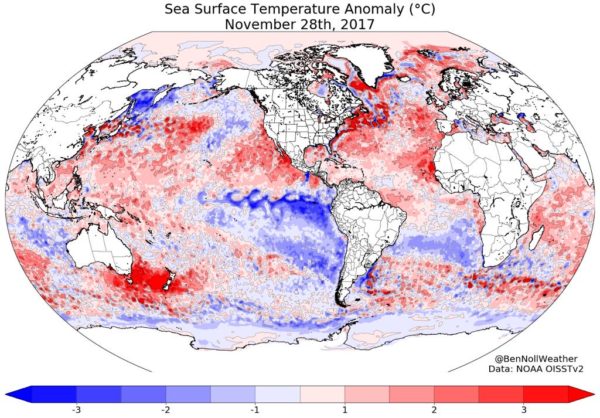Changing ocean currents
Several braided river bird species depend on coastal and marine ecosystems for food in winter. Changes to oceanic currents, including the Atlantic Meridional Overturning Circulation (AMOC) which helps drive the flow of food-rich cool waters past New Zealand, may alter water temperatures and vertical dispersal of nutrients through the water column. Changes are also occurring in the frequency and intensity of El Nina/La Nina, the Interdecadal Pacific Oscillation (IPO), and local currents around New Zealand.
Why is it a problem for braided rivers?
- Altered weather patterns (this website) Any change in the way currents flow around New Zealand, particularly a slowdown of the AMOC, will change the oceanic ecology, resulting in less winter food for those bird species that depend in part or full on coastal and oceanic ecosystems.
- Marine heatwaves (this website), which occur as a result of increasing temperatures, lead to phenological changes. Sessile species such as kelp forests already are dying, taking with them the biodiversity that they support. Tropical and invasive species already are replacing them (2019 summary article).
- Contribution to rising sea level (this website): higher sea temperatures (thermosteric changes) causes water to expand in volume, increasing sea levels. This is occurring globally as part of a suite of changes due to rising temperatures. The effects can be amplified regionally and locally due to changing oceanic currents delivering warmer than usual water to an area. It can also be amplified or dampened due to El Nina/La Nina and IPO. See for example NIWA Special Climate Statement (March 2018) – record warmth in the Tasman Sea, New Zealand and Tasmania:
“Sea surface temperatures in the southern Tasman Sea rose to exceptionally high levels in late 2017 and early 2018. These temperatures were far above any others previously observed at that time of year in the region, and extended west from New Zealand to Tasmania and mainland southeast Australia.”
However, short term (even decadal) changes in sea temperatures do not explain the long term decline in sea bird populations around New Zealand and Tasmania. Notice the highest number of threatened seabirds is in the same location as high water temperatures in 2018 (and again in 2019).


Research and references
Below are references to material specifically used in this page or are direct relevance. If you are interested in this topic, for the latest information we recommend Climate Central or the journal Nature Climate Change.
- Currents around New Zealand (Te Ara)
- Simple explanation of how AMOC works
- National Science Challenges
- 2019: (IPCC) Intergovernmental Panel on Climate Change’s special report on the oceans and cryosphere
- 2019: Major study uncovers ‘sea change’ in world’s understanding of Atlantic conveyor belt (link to the article explaining it, and link to research paper: Science 01 Feb 2019: Vol. 363, Issue 6426, pp. 516-521 DOI: 10.1126/science.aau6592
- 2019: Beaugrand; Prediction of unprecedented biological shifts in the global ocean. Nature Climate Change 9, 237-243
- 2019: Smale et al; Marine heatwaves threaten global biodiversity and the provision of ecosystem services. Nature Climate Change 9, 306–312
- 2018: Caeser et al; Observed fingerprint of a weakening Atlantic Ocean overturning circulation; Nature 556, 191–196
- 2018: Thornalley et al; Anomalously weak Labrador Sea convection and Atlantic overturning during the past 150 years; Nature 556, pp227–230
- 2018: Renner and Zohner; Climate Change and Phenological Mismatch in Trophic Interactions Among Plants, Insects, and Vertebrates; Annual Review of Ecology, Evolution, and Systematics Vol. 49:165-182
- 2018: Keogan et al; Global phenological insensitivity to shifting ocean temperatures among seabirds. Nature Climate Change, 2018; 8 (4)
- 2015: Paleczny et al; Population Trend of the World’s Monitored Seabirds 1950-2010, Plos One June 9, 2015
- 2014: Constable et al; Climate change and Southern Ocean ecosystems I: how changes in physical habitats directly affect marine biota. Global Change Biology Oct;20(10) pp3004-25
- 2010: Hoegh-Guldberg & Bruno; The Impact of Climate Change on the World’s Marine Ecosystems; Science Vol. 328, Issue 5985, pp. 1523 -1528
- See also Climate change/references (this website)
